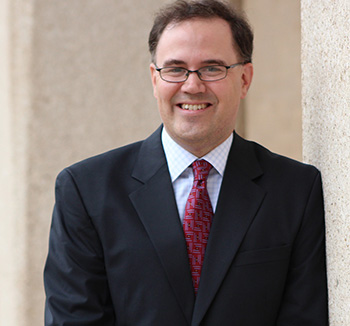
Adam R. Seipp
USC Shoah Foundation’s first-ever Texas A&M teaching fellow Adam R. Seipp is drawing on the Visual History Archive to help him fill some pretty big shoes.
Seipp, a professor of history, will be taking over Texas A&M’s Introduction to the Holocaust course following the retirement of beloved Professor Arnold Krammer. The course is one of the most popular at the school, so teaching it is an incredible responsibility, Seipp said – but, he’ll do it with the support of the A.I. and Manet Schepps Foundation Teaching Fellow program.
The fellowship provides summer support for one member of the Texas A&M University faculty each year for the next three years to integrate USC Shoah Foundation’s testimonies into new or existing courses.
Seipp was one of the first faculty at Texas A&M to begin using the Visual History Archive after the university acquired full access in 2009. He also attended USC Shoah Foundation’s 2010 international conference and contributed to the handbook Visual History Archive in Practice.
Under the fellowship, Seipp will develop an innovative new method for teaching Texas A&M’s Introduction to the Holocaust course. He plans to divide his class into teams, which will each investigate a different aspect of one of the final big death marches out of Dachau in spring 1945, such as the prisoners, the role of guards, or geography. Twenty-two survivors of this death march gave testimony to the Visual History Archive, which will provide the foundation for the class’s research.
Seipp said he was excited by the prospect of combining his own research interests (he’s already working on an article about this subject) with his teaching. Having his students conduct their own research in the Visual History Archive seemed like an ideal way to pull them into the material while drawing on their strengths – particularly their knack for multimedia.
It’s a bit of an experiment since Seipp has never taught a course like this before, but he said he’s looking forward to trying it out.
“The course will use technology available to our students so students can really sink their teeth into the material, and use these very rich sources to build something that’s perhaps different from what they might do in a lot of other history classes,” Seipp said. “I’m really looking forward to working with the Institute and getting some ideas from staff about how some of this might come to pass.”
In his experience, Seipp has found that testimony meets his students’ need to feel an emotional connection to the material they’re studying, and it engages students who might not otherwise be interested.
It also teaches students important skills including constructing an argument, using evidence, and analyzing different stories and narratives.
“These are the sorts of skills that whether or not they engage with the Holocaust again, students need when they go out into the world beyond their education,” Seipp said. “That’s part of what’s so exciting about teaching with these sources.”
Though Texas A&M is a major research institution – and campus Holocaust programming is typically very well-attended and piques a lot of students’ interest – many sources of Holocaust-related funding don’t reach the university, he said. The new fellowship, and the support of USC Shoah Foundation and the Schepps Foundation, is very encouraging.
“I’m really honored to be the first [fellow] and I’m certain I won’t be the last,” he said. “I’m really pleased to see this program moving forward.”